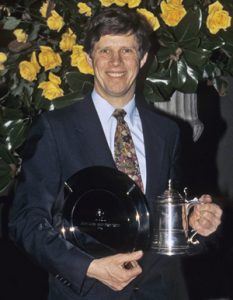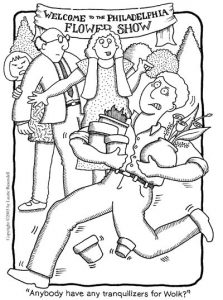A Botanical Biography
Art Wolk was born and raised in Philadelphia, Pennsylvania by parents whose idea of gardening was watching their neighbors tend vegetable and flower gardens. In fact, every ancestor he’s tracked down was a non-gardener, meaning Art is a mutant, an alien, or both.
Naturally, his wife, Arlene, and daughter, Beth, are both non-gardeners. So, Art’s been subjected to the warped views of non-gardeners all his life. The advantage is that he was able to give a relatively unbiased account of the unending confrontations between gardeners and non-gardeners. The disadvantage is that he grew up thinking gardening was something you did when no one was watching or under cover of darkness. This behavior was reinforced at the no-gardens-permitted apartment complex where he and Arlene lived when they were first married.
Eventually, Art reached the point where he didn’t give a damn about apartment rules or what non-gardeners thought about his garden or gardening activities, which, of course, were his first symptoms of hortiholism. His devious and deviant behavior has continued unabated, and he now admits to stealing cuttings in the past, nabbing his neighbors bagged leaves (for mulch), and pirating roadside ferns. On the other hand, his felonious activities haven’t stopped him from spending thousands of dollars on plants. At this point, he’s a prime candidate for a Hortiholics Anonymous retreat.
Art was a biology major at Temple University, where he took enough courses to learn how plants “think,” but not enough courses to realize he was the worst possible person to become a gardener: during his senior year, he was stung by a bee, went into anaphylactic shock, and barely survived. Of course, this made absolutely no difference in his choice of hobby, making him forevermore a death-defying flower gardener.
Life progressed fairly normally in the 1970’s, until an irreversible, life-altering event occurred: Art decided to enter a plant in the famed Philadelphia Flower Show in 1978 and, on his first try, won a blue ribbon. This single incident turned a fairly normal man into a blue-ribbon-hording flower show maniac. Basically, from that point forward, he procured plants using three criteria: 1) Could they win a blue ribbon? 2) Could they win a blue ribbon? and 3) Could they win a blue ribbon?

Although he’s non-prejudicial about which plants fit these three criteria, his favorites for exhibition are bulbs. Art’s lectures and publications about them often include odd statements, such as, “…they feel neglected,” “…they frolic in these conditions,” or “…they’re quite simply unhappy.” When he first made these comments to his wife, she stared at him in disbelief and began calling him a “Bulb Whisperer.”
By 1993, Art owned a greenhouse, or, more accurately, the greenhouse owned him. By the time he tried to win the Philadelphia Flower Show Grand Sweepstakes Award in 1995, he had plants hanging at the top of the greenhouse, plants crammed onto every shelf, specimens fighting for space on every growing bench, and plants crowding the floors and walkways. Amazingly, Art didn’t fall and break his neck, probably because he was more afraid he’d hurt his plants than his spine.
He managed to win the 1995 Grand Sweepstakes by driving himself and his wife and daughter to the Dark Side of Family Relationships. Suffice it to say that absolutely nothing out of the ordinary occurred during this quest, if you don’t count 1) breaking and entering a flower shop, 2) getting into an accident at the flower show’s unloading dock and not reporting it for a month, 3) forgetting all his plant entry forms, 4) trying to get to the flower show using a car completely encased in ice, and 5) entering 140 plants into the competition.
So, how did a book like Garden Lunacy: A Growing Concern come about? The simple answer is by luck and accident … actually, lots of accidents. He was lucky that he saw the humor inherent in gardening and gardeners. And, he was also lucky that he was asked to be president of the South Jersey Horticultural Society. When the newsletter editor asked him to write a president’s column, he decided to let loose his irreverent views on the skewed perceptions of avid gardeners like himself. And the accidents? Let’s just say that when it comes to gardening, and especially competing in flower shows, Art is more than a bit prone to disasters. The advantage is that this gives him lots of stories to tell. The disadvantage is that he might not live long enough after his next disaster to write about it.
Garden Lunacy wasn’t Art’s first foray into published writing: he had twenty magazine articles published before his book was completed. What’s incredible is that his writing career didn’t stop after his first article, since he and his first editor weren’t bosom friends … at least not at first. She was the type of editor who didn’t suffer fools gladly, and he was the type of writer who foolishly asked unending questions. When he visited her office for the first time, he was completely intimidated. This became complete trepidation when he saw a sign over her desk that read, “Editors are the ones who come out after the battle to kill the wounded!”

Luckily, he wasn’t wounded at the time.
Although no literary achievement matched the excitement of seeing his first publication in print, it took a year before Art wrote another article for the same editor. This time, he was very fortunate. The editor’s boss loved Art’s article, which made the editor very happy and also made an amazing thing happen: Art and the editor became good friends. He now admits that without her guidance he may never have found his literary muse.
By 1998, Art’s writing was becoming more and more about gardeners and less about plants. That year, he wrote a magazine article about a children’s garden he had started seven years earlier. It was a story he wrote more from his heart than his brain, and, incredibly, it won a writing award from the Garden Writers Association.
His reaction to reading the letter informing him that he had won wasn’t exactly subdued and dignified: he ran around the house as if he had suddenly been attacked by 10,000 fleas. Art and Arlene read the letter over and over, to be certain the words wouldn’t fly off the page. After five minutes, Arlene was in tears, and Art couldn’t stop thinking about his high school English teachers, spinning in their graves, who had told him he had the writing capability of a protozoan.
By 2000, Art had written over fifty newsletter articles that ultimately became the backbone of Garden Lunacy: A Growing Concern. He wrote for another two years, whenever he had the chance; this included middle-of-the-night visits to his computer, jotting down ideas while driving at 60 m.p.h., and frenetic scribbling while eating lunch (which many times found its way onto his lap and notepad).
When his first draft was completed, Garden Lunacy was about a million miles from being published, because Art subsequently edited it no less than thirty times. The only material that made the final cut were stories that still made him laugh out loud after the last edit. (And, that says a lot, because editing anything more than three times would make most writers retch.)
Art neither wrote Garden Lunacy to become a millionaire (although it wouldn’t make him depressed), nor to win prizes (although they’re not unpleasant to receive), but rather to make his readers laugh. So, if you chuckle out loud and occasionally get odd stares from people around you, you won’t be alone.
Art will be laughing along with you.